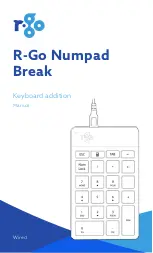
K2vx Reference Guide
Mirror Image Drum Map
35
Mirror Image Drum Map
The Mirror Image Drum Map is a new drumkit layout that enables a natural two-hand style of
playing. The Mirror Image Drum Map gets its name by its instruments being laid out in a mirror
image of itself with D4 being the point of reßection.
Getting Started
Play the key, D4. YouÕll notice that snare drum is assigned to it. From there, play 1 semitone down
(C#4), and up 1 semitone (D#4). Notice that the two are the same snare drum. Play 2 semitones down
(C4) and up 2 semitones (E4). Notice that the same bass drum is assigned to both keys. (Bass drum is
also repeated on E3 and C4, which is particularly useful in fast double bass drum playing.) Notes 3
semitones down, and up 3 semitones, have the same hi-hat, etc.
There are, however, two instances Ð G4 and E6 Ð where the left and right sides do not match. They
deviate from the mirror image scheme to accommodate the more familiar one hand playing of hi-hat
and tambourine.
The layout of the drums and various percussion instruments are easy to remember. Just keep in mind
that the basic drumkit consisting of Snare, Bass Drum, Toms, and Cymbals are in the range of C3-E5,
or the Òinner coreÓ range. The two remaining ranges (C2-B2 and F5-C7) which extend out to the left
and right edges of the keyboard make up the Òouter edgeÓ range, and will generally consist of
auxiliary percussion instruments. This ÒinnerÓ and ÒouterÓ range structure is also maintained in the
drum corps programs (#977, #980) and orchestral percussion programs (#978, #979).
It is easy to memorize the placement of instruments if you think of the double and triple groupings of
the black keys as one instrument or instrument type. Look at the center group of black keys, C#4 and
D#4. Think of that grouping as the snare drum. Fanning out on both sides to the next group of black
keys, F#3, G#3, A#3 on the left hand side, and F#4, G#4, A#4 on the right hand side, are the toms.
Fanning out farther to the next set of double black keys are the cymbals. The next set of triple black
keys are the timbales, and the next set of double black keys are the congas. The four white keys under
the toms are the hi-hats.
In the Òouter edgeÓ range, white keys are generally hand-held percussion toys or various useful
articulations of the congas laid out such that one can play typical conga patterns with one hand.
Try playing in a straight eighth note beat D#2, E2, F2, D#2, E2, F2, C2, C#2 and repeat. For easy right-
hand tambourine playing, try playing in the same eighth note beat C7, A6, E6, C7, A6, E6, C7, A6 and
repeat. Now combine the left-hand conga part and the right-hand tambourine. A combination of
easily Þngered patterns will often yield a useful rhythm section.
Sostenuto Pedal
One more bonus was added to the drumkit programsÑthe sostenuto pedal. Just hold down the
sostenuto pedal and again play in a steady eighth note beat E3, G3, A3, B3, G3, A3, B3, G3 and repeat.
The sostenuto adds percussion to the white keys ranging from F3 to C4, and C#4.
Sticking
The Mirror Image Drum Map lets you simulate the sticking that a real drummer would use. Try playing
a tom tom Þll from hi tom to low tom using a paradiddle sticking (RLRRLRLL). This should be very
easy to execute with minimal physical motion. The symmetrical inward-outward motion also feels
comfortable and smooth. Doubling or layering of instruments while maintaining the beat is as easy as
grabbing chords. A good example of this can be illustrated with program 977, ÒBig Drum CorpsÓ.
Play a steady repeating sixteenth note snare drum pattern with your left and right thumbs alternating
on the keys, C#4 and D#4. Keep that same left, right, left, right hand motion going but simply add
your index Þngers to play the next black keys which would be A#3 in the left hand and F#4 in the
right hand. Finally, add the ring Þnger for the low tom on F#3 and A#4. If you look at your hands
now the right hand is making an E ßat minor chord and its mirror image chord, F# Major, is in the left
hand. After playing with the drum programs youÕll notice how easy it is to play multiple drums in
unison or to add or drop a tom or crash cymbal while maintaining a continuous ßow of rhythm.
For those of you who prefer the old Kurzweil drum map for the drumkit programs, it is available on
the Controller slider.
Drumkit Programs: 984, 985
Drum Corps Programs: 977, 980
Orchestral Percussion Programs: 978, 979


































